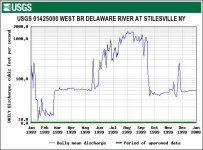Big_Spinner
Trout Hunter
Hi All,
Increase in release and the perfect amount of rain and the Delaware is transformed into a bug, fish and fishermen machine.
Just the right amount of bugs and good rising fish in places that a week ago, you would swear no fish existed.
Looks like more rain coming, so the Montague release will drop, too bad.
A bit more rain and the reservoirs will fill. This should mean a nice table change on June 1st that will restore the summer releases we have seen the last couple of summers of 500 cfs on the WB, 140 cfs on the EB and 110 on the NS.
Still wish we could get the EB up to about 190 cfs as a minimum.
Hope you got out fishing this weekend, it was so nice out.
Jim
Increase in release and the perfect amount of rain and the Delaware is transformed into a bug, fish and fishermen machine.
Just the right amount of bugs and good rising fish in places that a week ago, you would swear no fish existed.
Looks like more rain coming, so the Montague release will drop, too bad.
A bit more rain and the reservoirs will fill. This should mean a nice table change on June 1st that will restore the summer releases we have seen the last couple of summers of 500 cfs on the WB, 140 cfs on the EB and 110 on the NS.
Still wish we could get the EB up to about 190 cfs as a minimum.
Hope you got out fishing this weekend, it was so nice out.
Jim

